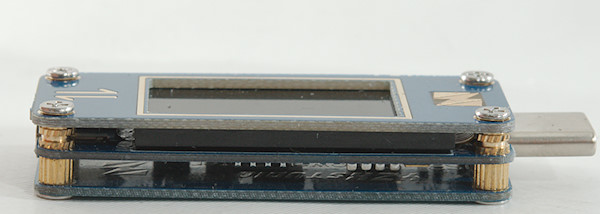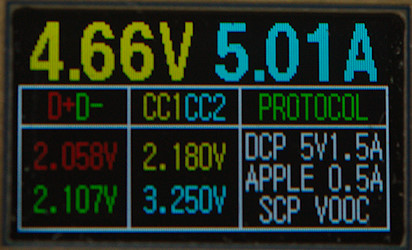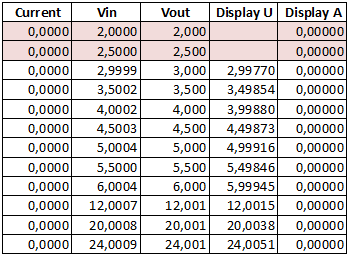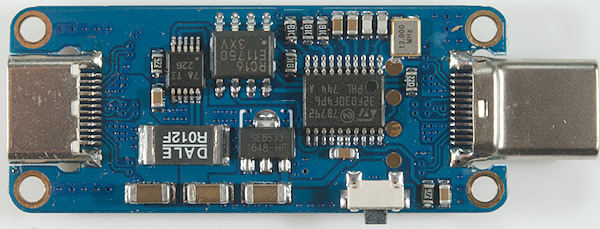YZXStudio USB meter ZY1278

Official specifications:
- Item: ZY1278
- Size: 41*17*8
- Display: 0.96 inch TFT
- Resolution: 160*80
- Communication: USB3.1Gen2
- Input port: C male
- Output port: C female
- Fast charge trigger: No
- PD straight through: YES
- Fast charge straight through: All models support the normal fast charge protocol through the meter
- VOOCDASH: Only DASH
- Upgrade method: ST-LINK upgrade
- Voltage accuracy: 0.1%±2d
- Current accuracy: 0.1%±2d
- Internal resistance is less than: 50mOhm
- Open screen power consumption: 17mA
- Off screen power consumption: 2mA
YZXStudio makes a series of usb meters, some of them very advanced.

I got the meter in a small metal can


Maximum specifications and connector information is listed on the back.

The button is on this side.



Display and functions

The screen with most information about current and voltage. The arrow shows current direction. Hold button down to select number of digits.

Next screen Wh, Ah and time.
Hold down the button to select group from 0 to 5, they are used to save the recorded values.

Next screen is the fast charge screen, it shows the voltage on the data and CC wires and tries to guess the protocol. If multiple protocols match the voltage, it will show multiple protocol names.
Hold button down to enter configuration.

Next screen is cable resistance measurement, it requires a constant current load and a fairly stable usb supply. First connect the usb meter directly to the power supply and hold down the button, then connect using the cable and the display will show cable and connection resistance.

Next screen is curves. It can either show voltage and current or the data lines, hold down the button to switch between them.
The curves will auto scale, this means they are fairly sensitive for even small variations.

Next screen is a simple screen with voltage, current and power, it uses a very fast update speed.
Hold down the button to change number of digits and flip the screen, the orientation will be used for all screens.
The last screen is "screen off", then the sequence starts from the first screen again.



Some examples on protocols, it do not identify the used PD coding.




The different configuration options.
Measurements
- USB-C output will not be enabled by this tester, the connected device must do that.
- The usb meter uses about 17mA current with normal brightness (10), 2 with display off.
- The internal resistance is about 0.12ohm (This includes both connectors).
- Usb meter will remember measured values when power is removed.
- There are 6 groups: 0 - 5
- This meter can show current in either direction.
- Backlight timeout can be adjusted in 1 minute steps up to 10 minutes, then in 5 minutes steps up above 4 hours or turned off.
- Curve update can be 0.1s/div, 0.2s/div, 0.5s/div, 1s/div, 3.6s/div, 5s/div, 10s/div, 20s/div
- Voltage display is within 0.1% when no current is flowing.
- Current display is within 0.3% high current has the largest tolerance.
- Software in tester is V3.36E

The voltage display is very precise with no current flowing, but there is too many digits.

The current display is also very precise and will not change with voltage and again there is too many digits.

M1: 72.0°C, HS1: 94.2°C

M1: 83.0°C, HS1: 96.2°C
The above IR photo was taken after 30minutes with 5A, the internal temperature is reported as 67°C
During that time the voltage readouts changed 0.6% and current 0.1%
Tear down

I had to remove 8 screws to open it, four for the back and four for the front.
The front and back have white graphic on the inside.

All the electronic are here, the processor (STMF030F4P6: ARM Cortex M0, 16kB flash, 4kB ram, 12 bit ADC), it do not have enough ADC resolution for this tester, this means there is an external ADC (Marked 7A TI / 226) and measure across a 0.012ohm resistor. The data is saved in a FRAM (MB85RC16: 16kbit). For powering this circuit there is a voltage regulator (SE8533: 3.3V).




There is nothing behind the display.

Conclusion
This is a high resolution usb meter for USB-C. It is nice it shows the CC voltage, but I am missing an interpretation of them. The resolution is a bit too much, one digit less would be fine.
I like it has both a USB-C male and female connector, this makes it easy to use without needing extra cables, that will add more resistance.
Notes
For these USB meters I used precise equipment (Keithley: DMM7510, 2280S, Keysight: 34470A).
How do I make the test































